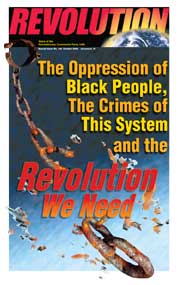Sights and Sounds of April 14
April 16, 2015 | Revolution Newspaper | revcom.us
A powerful movement to stop police brutality rose out of the streets of Ferguson, Missouri after the police murder of Mike Brown. It drew on the anger built up when a racist vigilante murdered Trayvon Martin and got a pat on the back from the system. It was fueled by the unbearable reality that every god damn day police shoot, brutalize, humiliate, terrorize, and murder Black and brown people—from Staten Island to Los Angeles, from Pasco, WA to South Carolina… and everywhere in between. That movement, last fall, rocked this country like nothing since the sixties.
But the powers-that-be lashed back. With beatings and arrests. With slander and lies. With bullshit about what a dangerous job it is to go out and murder Black and brown people with the full backing of the system. With entreaties to “have a conversation” coupled with threats. December came with stepped up repression and threats, and the movement got chilled.
So the question that HAD TO BE ANSWERED: Are the powers-that-be going to shut this all down? Or would people regroup, get back in the streets, and begin to take the movement against police murder to a higher level?
To quote our editorial: “The demonstrations against police murder on April 14 marked a new beginning for the struggle against this outrage. This is crucially important, for without mass struggle there can be no progress whatsoever and the powers-that-be will just hammer people into the ground. Further these demonstrations had important potential significance for revolution—for finally getting free of a society in which murder by police continues to go on daily and more, and people continue to be oppressed more generally... a society in which the lives of Black and other oppressed people are treated as if they do not matter. A14 was a great day, a great beginning—and now the challenge is to learn the lessons and take it further.
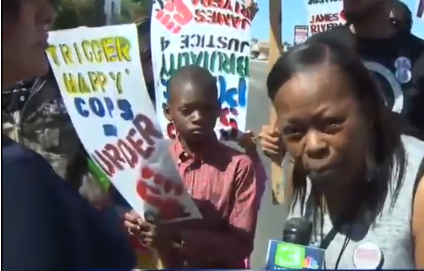
Stockton, California.
Among the cities where protests shut shit down: New York City; Chicago; Greensboro, North Carolina; Atlanta; Los Angeles; Houston; the San Francisco Bay Area; Springfield, Massachusetts; Stockton, California; Tulsa, Oklahoma; Seattle; Portland, Oregon; Cleveland; Pasco, Washington; Trenton, New Jersey; Detroit; Ferguson, Missouri; Birmingham; and Madison, Wisconsin. There are too many stories of defiance to recount here, and reports are still coming in, but the following gives a glimpse of what happened. Stay tuned to revcom.us for photos, interviews and video from around the country. We’ll update coverage as we learn more (and continue to send photos, video, and reports to revolution.reports@yahoo.com).
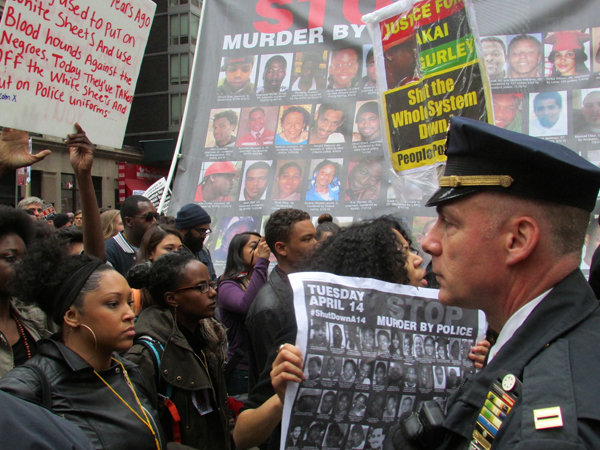
New York City
Demonstrations
There were marches of a thousand and more. And actions by a handful who got it, and who didn’t let the fact that everybody else doesn’t stop them. 1500 marched in New York City, tying up the Brooklyn Bridge and busting into world news coverage. In Birmingham, Alabama, three defiant ones with a Black Lives Matter banner shut down an intersection, caused a major commotion, and went to jail. In over 20 cities and on dozens of high school and college campuses, there was no business as usual on April 14. Protests took different forms, with different forces and views in the mix—determined and defiant that police murder must STOP and that this would not be a day of business as usual.
The largest protest took place in NYC where, starting last December, the mayor has felt it necessary to defend every instance of police murder and brutality, and to viciously slander and attack just protest against police brutality. Two hours before the main convergence a crew of about a dozen people, a mix of veteran revolutionaries and people from the ‘hood, gathered in Harlem to spread the word and mobilize more people to come down. An older man tapped out a beat on a hand-held drum which had a saying from the Bible. He had lived in Harlem since Malcolm X’s time and proudly remembered seeing him on the street; he said that things had only gotten worse since then.
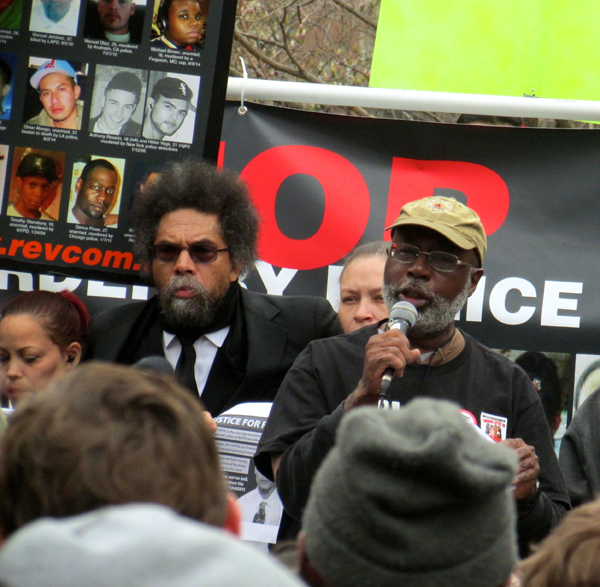
Cornel West and Carl Dix, initiators of the call for April 14, spoke in New York's Union Square.
At Union Square, Cornel West, who along with Carl Dix initiated the call for April 14, called out to a thousand people: “Let the word go forth here and now. It’s a new day in New York City! It’s a new day in the country! And it’s a new day because when those who some call everyday people straighten their backs up, they’re going somewhere. Cuz folk can’t ride your back unless it’s bent. And when you take a stand, when you’re willing to take a risk and tell the truth… and the condition of truth is always to allow suffering to speak. And when suffering speaks, the powers that be have to respond in some way. And there’s been too many folk, not just murdered, not just killed—systematically disrespected and we’ve reached the point where we can’t take it any longer!”
Speaking of the challenge, Carl Dix told the crowd in Union Square: “Now, when you say you’re going to stop something as serious as that, you gotta get organized. That’s why Cornel and I formed the Stop Mass Incarceration Network. It exists to build resistance to this genocide that’s coming down. It’s a slow genocide right now, but it could speed up at any moment. If you want to see this genocide stopped then you need to get with us. The Network, the Stop Mass Incarceration Network, has people who come at things differently—we don’t all believe the same things, we don’t all practice and think the same way—but we all think that police murdering people, that people being warehoused in prison, treated like less than full human beings must stop, and we come together to stop it. Look, if you feel that way, then you need to join with the Stop Mass Incarceration Network. Sign up on the sheet with it, come out to the next meeting and be part of building up the resistance that can stop this shit.
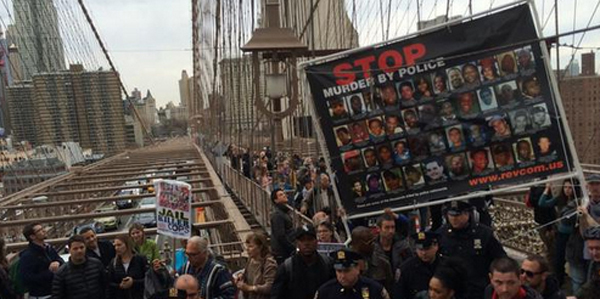
In New York people hopped over high fences to get into the lanes of traffic on the Brooklyn Bridge.
“Now, those of you who know me know that I’m a revolutionary communist and that I will always tell you that things don’t have to be this way. We don’t have to put up with police murdering our youth. We can end all of this stuff, but it’s gonna take revolution, nothing less, to do it. That is what I am out here for, that’s what I’m working on. That’s what the Revolutionary Communist Party and its leader Bob Avakian are working on...”
Marching from Union Square, picking up people as they headed to the Brooklyn Bridge where those young and daring enough hopped over high fences and streamed into lanes of traffic.
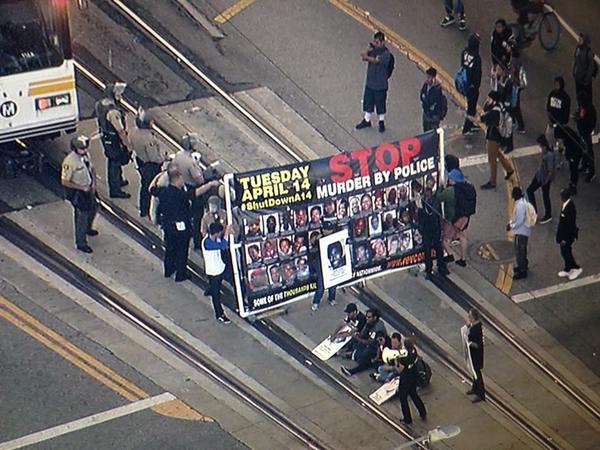
Blocking the train in Los Angeles.
In Los Angeles, after a rally of nearly 1000 people, dozens of protesters determined to keep shutting it down on A14 to STOP police murder stayed in the downtown area through rush hour. Twenty of them sat down in a very busy intersection downtown stopping the Blue Line Metro train, backing up street and freeway traffic for over an hour.
In both San Francisco and Oakland, protesters stormed into City Halls, confronting the powers-that-be and media with posters of those whose lives had been taken by police. In Portland, San Francisco, and Oakland freeways were shut down or blocked. In Stockton, CA, one of the busiest intersections was shut down. And there were defiant, determined protests in other places as well.
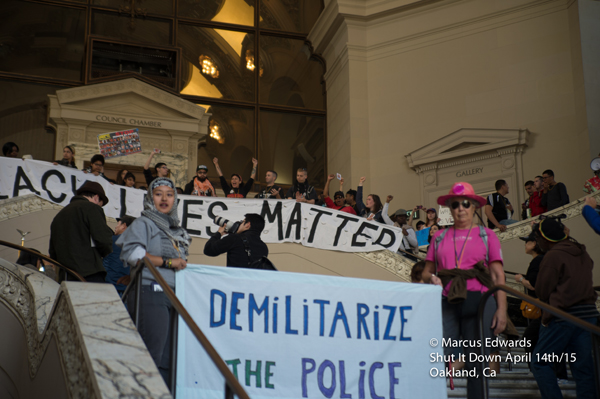
Inside the Oakland, California, City Hall.
Out of the Schools…
High school and college students broke out of dozens of schools and shook up business as usual in their schools, and in society.
In Los Angeles, a teacher told a young woman she was "too small to make a change." She responded: "Look how many people I got to walk out w/ me!" Students at Kenwood Academy in Chicago staged an exuberant walkout, and two were arrested. Over 30 students walked out of Brooklyn Friends HS to march in NYC.
In Madison, high school students and others shut down East Washington for hours—several were arrested. Including a member of the media whose camera was destroyed. A statement by Young Gifted and Black said “Community members are outraged but unsurprised by this gross display of state power by MPD.”
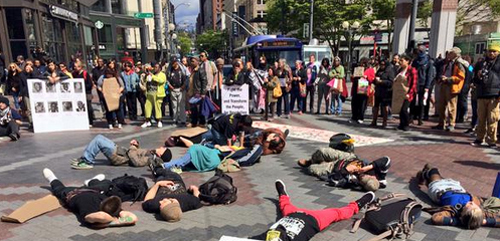
Die-In in Seattle
There were die-ins at UCLA, UMass Amherst, and University of Wisconsin (Madison). Students walked out and rallied on campuses including Washington U in St. Louis and Columbia in NYC. At John Caroll University in Ohio, the Black Student Union reported police "tore down our signs advertising this event." About 30 students at Seattle Central College (SCC), a working class community college with many Black and multinational students, walked out of class after a smaller group of students, organizers and people from the community marched and chanted through the hallways, up and down staircases, and held die-ins and speak-outs in the halls and cafeteria. During a speak-out in the cafeteria, a Black male student went on about the real problem is "Black on Black crime." This was taken on by a Black woman, who encouraged people to not be tricked, saying that this is a lie to get people to think that Black people are less-than-human animals. The SCC students then marched to a nearby Catholic university, where they picked up a couple dozen more people—one said “I had to join because those are my people (the faces on the banner), you are my people (the protesters)." The students joined 200 people blocking major streets in downtown Seattle during rush hour.
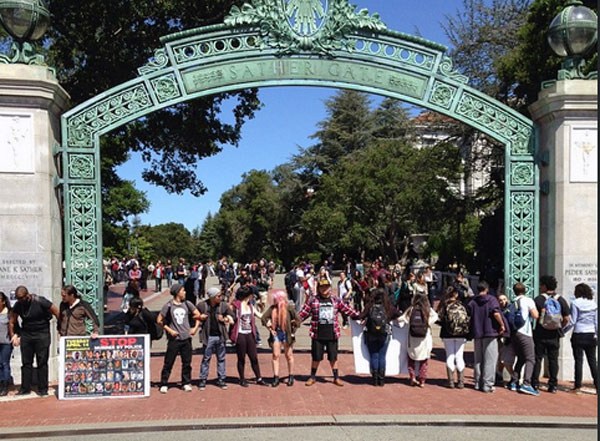
Blocking the main entrance to the University of California at Berkeley, Sather Gate.
At U.C. Berkeley, fifteen students took a determined stand at the main entrance. That determination, including in the face of other students who resented having their routine disrupted, compelled dozens more—with up to 75 people physically blocking the entrance. A correspondent made an important observation: “This made a critical difference, it turned from symbolic protest to a real SHUTDOWN. And shutting down the thoroughfare of these students rushing pell mell to lunch or from one class to another is something. This is a wave of hundreds, probably thousands, streaming through in a matter of 10 minutes or so, and it is often very frustrating to try and reach these students in this mode—blinders on, seemingly oblivious to anything but where they’re getting next. So that herd-mode was turned on its head and stopped—forcing students to stop and confront this and think about it for real. As one Black student said: people can ignore a leaflet or a rally or a conversation, but they can’t ignore this!” The correspondent added, “It really struck me that some of the sharpest ideological struggle has to go on with those people who think they already know, or they’re already opposed to racism so they’re cool or doing all they can. Most of the UC students were respectful and basically supportive, a relative few tried to bust through the lines."
Breadth and Determination
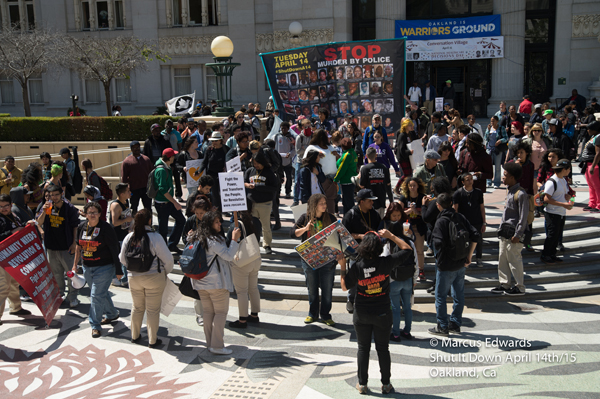
Revolution Club in Oakland, California
There was an inspiring breadth to the events. At the core, dedicated activists in the Stop Mass Incarceration Network, and revolutionary communists for whom the struggle to end police brutality and murder is tightly integrated into building a movement for revolution that will end ALL oppression. This core included people who saw the Dialogue, Revolution and Religion with Bob Avakian, the leader of the movement for communist revolution, and the revolutionary Christian Cornel West. Carl Dix from the Revolutionary Communist Party and others associated with the RCP were an unshakable force, giving backbone and heart to those who looked to them for leadership, and a compelling challenge to a wide range of forces, and—including through alternative media and breaking into the mainstream—reaching millions. Revolution Clubs in several cities were a critical presence, rushing to the front of the struggle, and inviting people into the movement for revolution and communism.
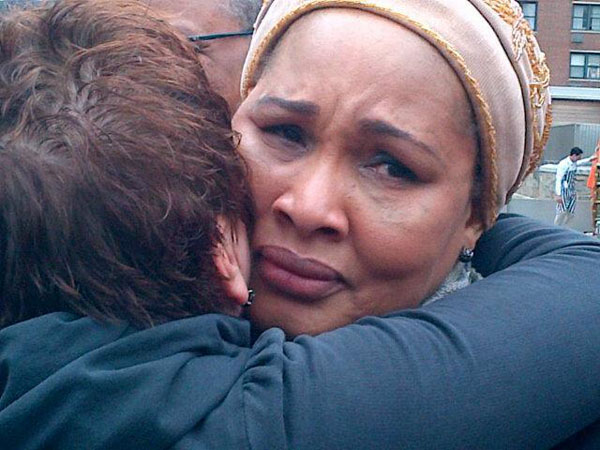
New York—Eve Ensler hugs Hawa Bah, whose son Mohamed was killed by police.
There were the courageous families of people whose loved ones were taken from them by police murder. Some were brand new to the struggle. Others, like Nicholas Heyward Sr, or Juanita Young have been fighting police murder for as long as twenty years—not just for their own sake but for everyone else as well.
In NYC, activists supporting the 43 Mexican students from Ayotzinapa kidnapped by the government marched—their banner with the faces of the 43 missing victims in painful synergy with the huge banners of victims of police murder in the U.S. and infusing the march with a global consciousness.
Those Who Catch the Most Hell and Voices of Conscience
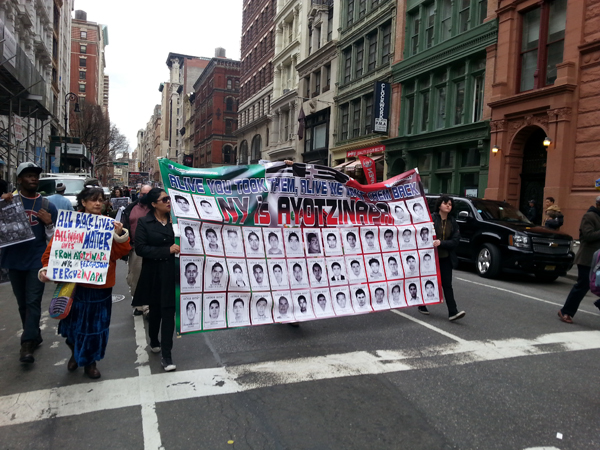
In New York City, activists supporting the 43 Mexican students from Ayotzinapa kidnapped by the government marched—their banner with the faces of the 43 missing victims in painful synergy with the huge banners of victims of police murder in the U.S. and infusing the march with a global consciousness.
The mix varied from city to city, but in many places, the people who catch the most hell on a daily basis in ameriKKKa were on the cutting edge. In infamous Ferguson, MO, Black youth were literally dancing in the street in front of the police station on April 14, and in Chicago, the majority of the 300 who took to the streets were Black people. One high school student who said he marched because "The police are continually killing black children and nothing's happening. So today we are going to march. I am going to march for my black people.” In a number of cities including Cleveland and Stockton, those in the streets were in large part from communities of the most oppressed.
And there were people of all nationalities and walks of life who stood with them.
A still-small but all the more inspiring representation of voices of conscience from the arts, entertainment, and politics lent moral strength and made it harder to attack the protests, and harder to turn away from them. Several important statements of conscience were issued in advance of the day.
Ferguson, Missouri youth dancing in the street in front of the police station. Video special to revcom.us
On the 14th, poet, journalist and human rights activist Rose Styron issued a statement: “The shooting of unarmed blacks, Hispanics and poor youths on the streets of America, and the long-term incarceration of young offenders are among the most flagrant examples of failure in our policy and justice systems. March on today!”
At Georgia State in Atlanta, rapper Jasiri X got on the mic as students blocked a walkway with a banner of photos of victims of police murder. Residente from the musical group Calle 13 tweeted a photo of himself with Cornel West and Carl Dix at the rally in NYC.
Jazz great Arturo O’Farrill spoke in New York City: “It’s very simple—you have to connect your life, you have to connect your art, you have to connect your job, you have to connect your soul to something that is bigger than you. You have to connect all of this to justice. You connect to caring, to loving, to loving one another and demanding better of the NYPD, the SFPD, the LAPD. If we don’t demand better from them, they are paid to govern and protect us. We cannot sit idly by while they kill our children. No more! No more killing young Blacks and Hispanics! This moment has to end!”
Legendary feminist Eve Ensler was at the front of the march in New York City. She issued a powerful statement that included “I am here today in outrage and sorrow. I am here to say no to the racist epidemic of police murders of black and brown women and men and children that continues despite massive protests and outcry. I am here to say we must escalate our efforts and our resistance to these gruesome shootings. I refuse the 8 bullets in Walter Scott’s back, the 12 bullets in Michael Brown’s chest, the 4 Taser shots that killed Natasha McKenna. I refuse the knee in the back that smashed Tanisha Anderson, the 2 bullets in Yvette Smith, the 23 bullets in Malissa Williams, the 2 bullets in 12 year old Tamir Rice’s chest, the bullets fired into Meagan Hockaday just 20 seconds after they arrived in her home. I refuse the bullets of a police state that continues to murder the oppressed rather than lifting their conditions. I call on every white person who has the privilege of walking the streets without fear of being snuffed out by those who brazenly exercise their license to kill, to walk out today and every day until our brothers and sisters are safe and free. I stand with a broken heart for the families, for the friends for the terrorized witnesses, for their sorrow and loss.”
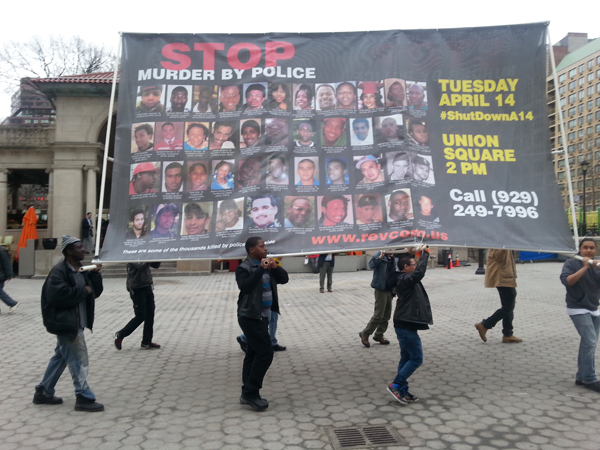
Everywhere people carried giant 10-15 foot-long banners of the iconic "Stolen Lives" poster; compelling others to stand with the marches.
Wherever the Stolen Lives banner went, it drew a line in the sand. People saw faces they knew, and loved. People who hadn’t a clue as to the extent of police murder were shaken up. Nobody could just walk on by.
Voices of Faith
Religious forces were an important part of the strength of the day. Speaking in Union Square in New York City, Reverend Calvin Butts declared “I have come today to represent with members of the clergy from all five boroughs. The power of the church must stand with the people in this because we can no longer watch our young people be shot down. I’ve watched this for over 40 years. And we get the same story each and every time. Enough is enough! And we must, we must, stand up! We must stand together because power is the only thing that power understands. Shut it down!” Reverend Butts helped mobilize a coalition of clergy from around the city that marched together on April 14.
Rabbi Michael Lerner of the Network of Spiritual Progressives spoke in both Oakland and San Francisco. He said “In this society there is a racism that is deep and imbedded and has not gone away. We have to recognize that every specific manifestation of that racism has to be stood up to and fought against” And, that “The only way to counter this is to have a different world view that says that we are all in this together… That there is a fundamental unity and that unity has to extend to all the divisions in this country but to recognize our fundamental unity with all people on this planet."
Reverend Amos Brown, San Francisco branch president of the National Association for the Advancement of Colored People, was in the crowd in San Francisco on April 14 and said, “I know that business as usual has been interrupted, but there comes a time when we the oppressed must rise up.”
A contingent behind a banner from St. Paul and St. Andrews United Methodist Church was in the crowd in Union Square.
Frederick A. Davie, M.Div. , Executive Vice-President, Secretary to the Board of Trustees at Union Theological Seminary in the City of New York sent out an email that included: “Students, faculty and staff are welcome to make their own choices about attending the Shut It Down Rally tomorrow in Union Square at 2pm…. Serene and I are fully supportive of this event, as we are horrified by the killing of primarily black and brown people by law enforcement in our nation. If you do decide to attend the event, please be safe and exercise care."
Pigs Acting Like Pigs
In many places, the authorities, who send their police out to kill every day, sent their police to attack the protests. In Cleveland police brought out horses to corral and attack the protest. There were dozens of arrests in NYC, and at least two people were seriously injured in vicious police assaults.

In Cleveland, Ohio, police brought out horses to corral and attack the protest.
Over a dozen people were arrested in Springfield, MA and authorities published the names, faces, and addresses of those arrested. A protester defiantly responded, “The mayor needs to be here, see this, be arm-in-arm with us and standing up with this to let the system know we are no longer going to sit back and watch our black and brown children get killed.” And when asked about the arrests, he said, “That’s how much it means to us, that’s why we put our lives on the line. This means so much to us, we’re fighting to survive.”
There were dozens of arrests in other places as well. Having the backs of those attacked and arrested is critical to defending and building the movement.
Being part of this was transforming, for all involved. At the emergency meeting in Manhattan to make plans to respond to the police attacks, where there was controversy over whether it had been right, and worth it, to actually SHUT IT DOWN on the Brooklyn Bridge, a 16-year-old woman high school student who had been arrested said that A14 was "the best day of my life."
Heard Around the World
April 14 was heard around the world. The press in Europe, the Middle East, and Latin America gave significant coverage to the protests, and people heard about them around the world from going to revcom.us. And people around the world are attuned to the state of struggle in the empire built on genocide, slavery, and unjust wars.
A Revolution reader from South America wrote: “I am very proud about what you did on A14 (and what you are doing now). I am watching photos and videos that you are publishing, it is very inspiring for me to know that there, in ‘the belly of the beast’ as you say, the people are beginning to awake. It is important for the world that in the USA, people in general and revolutionaries in particular, have a very strong movement for the revolution, it is important to publish more of the A14 in order to break the block out of the official media, the media of the imperialist burgueois, that never will talk about the movement that is borning now, ‘the American spring’, that will remove the very base of the imperialist system.”
* * *
All this shows, more than anything else, the potential for the movement that was revived and strengthened on April 14 to burst out on a whole other level.
Volunteers Needed... for revcom.us and Revolution
If you like this article, subscribe, donate to and sustain Revolution newspaper.





